This is how to tenderise beef with a Chinese restaurant method called “velveting beef”. Also used for chicken, it’s a simple, highly effective technique using baking soda that transforms economical beef so it’s incredibly tender in stir fries and stir fried noodles.
It’s a quick and easy method that any home cook can do, any night of the week. No deep frying, no special equipment. This is a game changer!
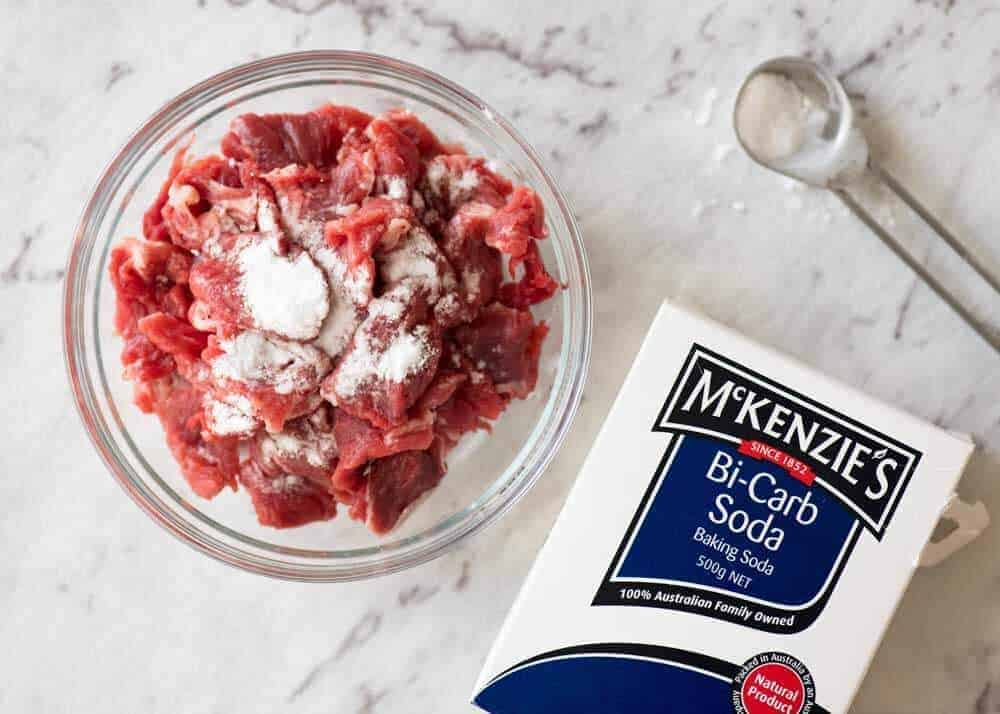

How do Chinese restaurants get their beef so tender??
Ever notice how the beef at Chinese restaurants is so incredibly tender, and how your stir fries at home are just never the same?
The secret is tenderising the meat. It’s called velveting beef.
Your cheerful local Chinese restaurant is using economical stewing beef to make stir fries with ultra tender strips of beef by tenderising it!
How to tenderise beef – easily!
There are a few methods, but this is the easiest way:
-
Sprinkle 3/4 tsp baking soda (bi-carbonate soda) on 250g / 8oz sliced economical beef cuts
-
Toss with fingers, leave for 30 minutes
-
Rinse, pat off excess water
-
Proceed with stir fry recipe. It can be marinated with wet or dry seasonings, or cooked plain. The beef will be really tender and soft, “velvet’ like. Just like in stir fries made by your favourite Chinese restaurant!
Other tenderising methods include marinating in a cornflour/cornstarch sludge then frying in oil before using in the stir fry, chemical tenderisers and egg white marinates. The baking soda method is the simplest for every day purposes and just as effective which is why it’s the method I use.

Beef cuts to tenderise
These are the best cuts of beef to tenderise:
-
economical steaks* – any type, like good value rump, porterhouse, sirloin, round bottom etc. that are otherwise quite dry when used in stir fries;
-
chuck and similar cuts of beef used for stews – this technique will tenderise the beef perfectly, however, by their very nature, stewing cuts of beef don’t have as strong a natural beef flavour as steaks. However, I’m fine with that because stir fries always have great sauces!
* It sounds counterintuitive to tenderise steaks because one would assume if beef is sold labelled as “steaks”, that indicates they’re good for quick cooking (eg grilling) so it should be good for stir fries. But it’s not – even steaks range from economical to high quality. You can use any high quality (expensive) steak in stir fries without tenderising (which is what fine dining Asian restaurants do). Use this tenderising technique on budget steaks, not expensive steaks.
Tenderising time
Tenderising time differs for different cuts of beef. Here’s the general rule of thumb I’ve come up with based on all the beef I’ve tried:
-
Chuck beef, gravy beef, oyster beef and other traditional stewing beef – 30 minutes
-
Economical steak cuts (eg. cheap rump, hanger) – 20 minutes
-
Blade, bolar blade – 40 minutes
-
Brisket – the only cut I don’t recommend, haven’t been 100% happy with outcome
If you’re unsure for your cut of beef, go for 35 minutes. Even when I under or over tenderised, it was still tender and juicy. You’ll quickly figure out the best marinating times for your preferred cuts of beef – just adjust up and down by 10 minutes at a time.
Word of caution: The beef will turn freakishly bright red. See?
Don’t be alarmed – that’s just what happens. In fact, if you put your ear very close to the beef, you’ll hear faint fizzing – that’s the baking soda at work!

Marinating Tenderised Beef
After it’s been tenderised, go ahead and marinate it in whatever you want – wet sauce or dry seasonings. Because we’re using thin slices of beef here and it’s been tenderised, we don’t need to marinate for long. Even 10 minutes will suffice.
Also, stir fries have the benefit of glossy sauces coating the beef so that’s another reason why we do not need to marinate it for long.
Pictured below is the stir fry sauce / marinade for Chinese Beef and Broccoli.
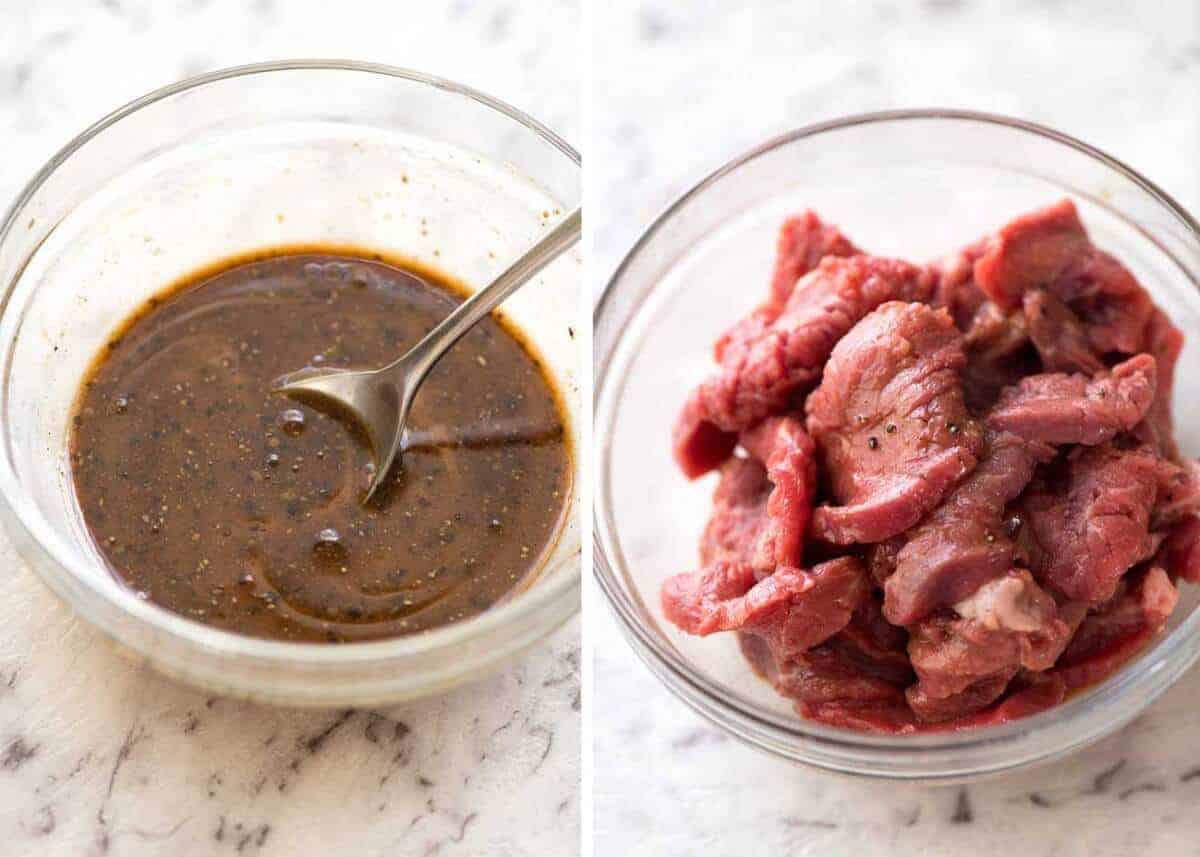
How to cook tenderised beef
Tenderised beef can be stir fried the traditional way – hard and fast on a hot stove in mere minutes – or even deep or shallow fried in oil like in this Crispy Mongolian Beef (pictured below).
Whichever way you cook it, the beef comes out much more tender and juicy than even expensive cuts of beef like beef tenderloin!
What does tenderised beef taste like?
The flavour of the beef is not affected by the tenderising. So the beef flavour will only be as good as the cut you use.
Tenderising affects the texture not the flavour of the beef. It has a “velvety” texture. The fibres are softened so you get less “meaty” texture, which is why I only use this technique to tenderise strips of meat and not cubes or steaks which would be a bit too eerie!

Why tenderise beef?
Tenderising beef enables you to make fast-cook beef recipes using economical cuts of beef that usually require slow cooking to break down the tough fibres, like in Stews. And it stays tender even if you overcook the beef!
What to make with tenderised beef
Because this is a Chinese restaurant method, I’m sharing this with stir fries like Beef and Broccoli and stir fried noodles in mind. Build your own stir fry using my All Purpose Chinese Stir Fry Sauce or Peanut Sauce for stir fries!
You can also use tenderised beef in place of chicken or pork in any of the stir fries.
But don’t limit yourself to just Chinese recipes! The plain tenderised beef isn’t flavoured, so it can be used for any recipe calling for strips of beef that are cooked quickly, such as Beef Stroganoff.
If you try this tenderising technique, I’d love to know what you think! – Nagi x
Hungry for more? Subscribe to my newsletter and follow along on Facebook, Pinterest and Instagram for all of the latest updates.
How to tenderise beef (velveting beef)
Ingredients
- 250 g / 8 oz stewing beef or other economical beef cuts (Note 1)
- 3/4 tsp baking soda / bi-carbonate soda (Note 2)
Instructions
- Slice beef thinly against the grain. (Note 3)
- Place in a bowl. Sprinkle over baking soda, toss with fingers to coat evenly.
- Refrigerate for 30 to 40 minutes. (See Note 1 for different cuts)
- Rinse beef well with tap water. Shake off excess water, then use paper towels to blot away excess water (doesn't need to be 100% dry).
- Proceed with recipe of choice. Beef can be marinated or seasoned before cooking, stir fried or deep fried, and it will be soft and tender, "velvet" like. Use for Stir Fries, Stir Fried Noodles, Beef Stroganoff and any other recipe calling for quick-cooked beef strips.
Recipe Notes:
1. Beef cuts - Use this for stewing cuts and to improve the tenderness of economical steaks. It will work with any cut of beef but is obviously wasted on expensive beef like tenderloin or high quality, well marbled fillets and rib eyes. Tenderising time differs for different cuts of beef. Here's the general rule of thumb I've come up with based on all the beef I've tried:
- Chuck beef, gravy beef, oyster beef and other traditional stewing beef - 30 minutes
- Economical steak cuts (eg. cheap rump, hanger) - 20 minutes
- Blade, bolar blade - 40 minutes
- Brisket - the only cut I don't recommend, haven't been 100% happy with outcome
Nutrition Information:
Life of Dozer
This is the only beef he’s getting today… 😂

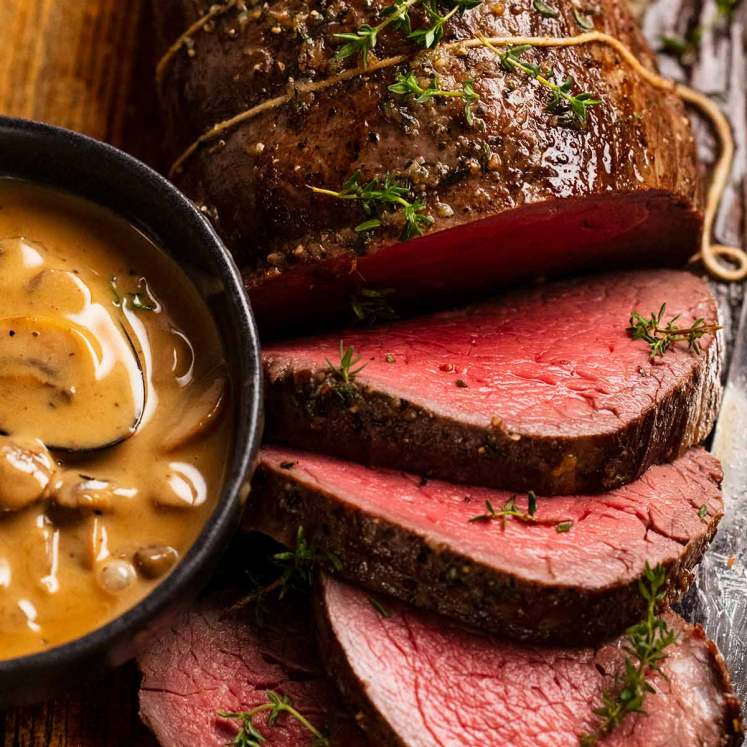
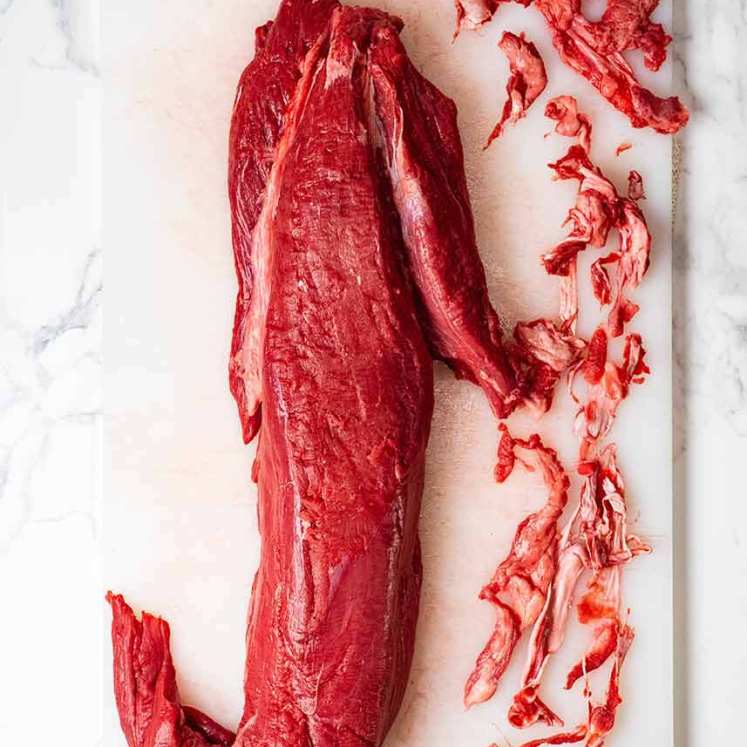
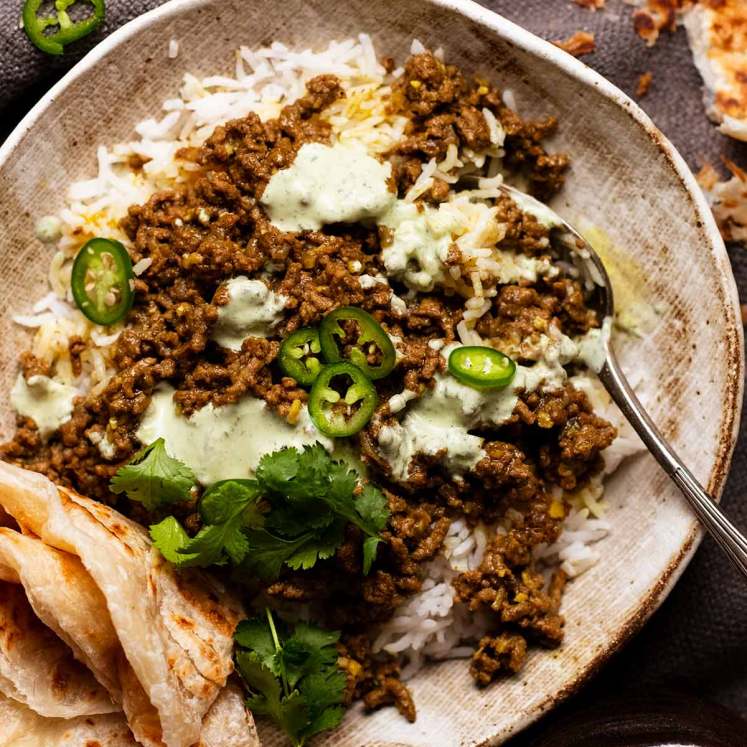
Normally I love Nagi’s recipes, but this one didn’t work for me. I added 1.5tsp baking soda to 500g of pork and thoroughly rinsed it off after 25 minutes in the fridge. It definitely made the pork softer but the smell caused by the baking soda was unbearable, even after rinsing as best I could. It was a strange fish & soap smell. Both the pork and the baking soda were fresh and did not smell beforehand. After marinating the pork, I tried to cook it in the hope the smell would disappear. The smell actually got worse, and I did not dare to do a taste test. Had to throw the pork away and order takeaway 🙁
Is it just me or did this make anyone else meat smell bad?
I checked the chopping board and that didn’t smell so I added bicarb to it and it had the same “off” smell.
I will trust the process but I don’t want to eat bad meat.
Thanks for sharing. I am surprised by the difference it makes with beef in my recipes.
I followed the directions rinsed well but the beef tastes a bit funny – am I doing something wrong?
After reading some of the comments I think I may have been using ‘ stale ‘ bi carb – I’ll try again with a fresh packet 👍
Hello Nagi, I have a quick question. On your website, you show how to tell if your baking powder is good or bad. But, is there a way to tell if your baking soda is good or bad? Or should I say strong enough to tenderize your beef strips? I hope that’s not a stupid question, but since I didn’t see it on your website, I thought I would ask. Just Love my Cookbook! And of course you and Dozer. Give him a nice belly rub from me please! Thanks! 😊 🌎☮️
OMG I love this! It worked so well on some thin-sliced top round, I’m impressed. I have been cooking for a lot of years and I wish I’d known this sooner. We old cooks CAN learn new tricks!
This method is great! I can get fairly cheap shaved steak but it never cooks up tender- a sprinkle of baking soda along with salt and pepper, let is sit for 20 mins and it fries us so soft! I also tenderize chunks of chicken breast this way to add to soups.
Nagi & Dozer – LOVE your site and cookbook! My husband Jeff and I feel like you are part of our family! I have many dietary restrictions and they have changed over the years (and change how I can cook). I only used to use coconut aminos but I was ok after I added in some Bragg liquid aminos (soy based) and some legumes (YAY!). I have tamari in stock as well. We went to Asian supermarket yesterday – it was an adventure ;-0! I bought a variety of noodles that I can eat (It’s been a decade since I had noodles!) I bought Japchae (I’m going to make that) and use rice sticks in your Lo Mein recipe; also bought Longkou pea noodles, high grade Shaoxing, Lee Kum Kee brand Gluten free soy sauce and Vegan oyster flavored sauce. Nothing there said Dark Soy that was gluten free. Could you tell me if any of the sauce ingredients I have would stain like dark soy and/or what combo and amounts to use in your Lo Mein? I so appreciate being able to travel the world with the food I make that I can tailor to my health needs! (still can’t eat nightshades, wheat (gluten), or dairy) Asian was the last to tackle because of prevalence of wheat, corn, MSG, sugar, potato in many sauces. My husband and I love reading your travel stories and sharing your life and Dozer with us! I’m also going to try the tenderizing of sirloin tip steak when I make Japchae. Thanks so much for all you do!!!!
I velveted minute steak and made a beef and black bean . The family thought I’d actually bought it from the local Chinese! So easy.
Followed instructions exactly to velvet some extra top round (thin slices across the grain) – first time I got the texture I wanted for my pepper steak (fam thought it was takeout!). Thank you so much!
Love your very well explained receipes. So easy to follow, and soooo delicious. I have tried velveting the beef and wow what a difference. Can’t wait to cook it again.
Thanks Nagi.
1st rate once again Nagi!!!
Hi Nagi,
I was wondering what is the best way to tenderise cubes of beef or is it only good for slow cooking?
Love your website and of course I bought a book for myself and my sister in law.
I used this technique on top sirloin as that was all I had the second time making your beef stroganoff. The meat was as tender as a ribeye…..
Awesome technique! Tanks for sharing.
Velveting beef for stir fry – what a winner of a tip. This worked beautifully. My stir fry turned out awesome because of this tip. Thank you 🥰🌺 Nagi for sharing these wonderful tips with us all.
Velveting beef for stir fry – what a winner of a tip. This worked beautifully. My stir fry turned out awesome because of this tip. Thank you 🥰🌺 Nagi for sharing these wonderful tips with us all.
Absolutely love that velveting tip, I used rump steak to make your chow mein and it was fantastic. I’m really impressed and I’ll definitely be making it again. Thanks Nagi
Does this work on venison?
Hi Nagi and Dozer,
Everybody told me, I am a good cook. Since I am using your recipes and tricks since 2 years, everybody telling me, I am a magnificent cook.
Thanks Nagi
The best parts of you delicious recipes your humour and big smile.
Used this on gravy beef and my tikki masala was so tender!
Velvet ing the meat worked great! We both loved the taste and texture. Did brisket, left over it’s in fridge, and followed the rest of your instructions exactly, we then. Canned it. Best canned brisket ever. Chunks were 1.5 in by same. Next time will try less soda to work it out perfectly for us! Thank you, Linda